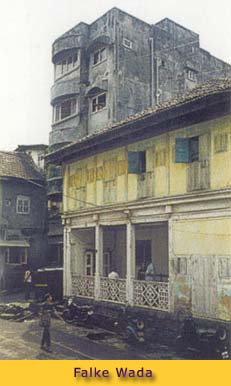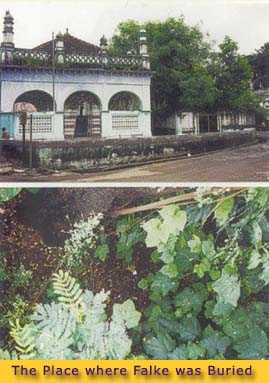|
. Haji Mohammed Siddique Falke was born in Kalyan around 1841. He was an affluent landowner and possessed vast acres of farmlands. He was sophisticated, well-read, intelligent and very spiritual. He had travelled widely to places like Bhagdad, Constantinople and Mecca. Dada Sahib Khaparde has recorded the following on one of his visits to Shirdi dated 14th December 1911 to 23rd December 1911 in his “Shirdi Diary”. Dada Sahib Khaparde states “Siddique Falke was a Gentleman of the ‘old sort’. He was a Karma-Margi or a person who performed actions and deeds without an ulterior motive and was very intelligent. He was spiritually developed and learned; the conversations that they had were pleasant and instructive. Baba like Falke a great deal and is said to have granted his wish”. During that visit, Falke had a dream vision and he asked Dada Sahib to ask Baba its meaning. The vision was about three girls and a blind woman who had come to amuse him. He ordered them to get out or they would be kicked out. Then he began to pray loudly. They fled upon hearing his prayers. He then blessed everyone in the room; and in the house, and the whole village. The possible meaning of the dream is as follows. The three girls represent the trigunas, i.e., Satva, Rajas and Tamas. The Blind woman represents Maya. All these will amuse the Jeevatma by taking them in their control. If the Jeevatma wants to merge with the Parabrahma, then he has to transcend the Trigunas and overcome the Maya. This transcending process of Falke is symbolically expressed by way of ordering them to go out and kicking them. Falke can acquire this power only by means of Prayers. Falke by doing prayer had transcended the Trigunas and Maya and had “Self Realization”. Baba said to Dada Sahib Khaparde who was seated before him “He was beaten by something on his private parts and hands. He then applied some oil and wandered about, had a stool and felt better near the fire” meaning Falke has beaten the Trigunas (three girls) and Maya and applied oil (which symbolizes prayer) which acts as coating for actions of Trigunas and Maya. He then wandered and had a stool symbolizes the purging of Sanchit Karma. Haji Siddique Falke was married to Kursheed and had two sons named Gulam Mustafa and Mohammed Mukram. His descendants still live in the Falke Wada in Kalyan.
Like Falke they are well educated and extremely affluent. He loved to wear spotless white clothes. Whenever the Dwarakamai was washed with cow dung, Baba would summon Falke and make him sit on the wet floor much to Falke’s discontent. However, when he got up his clothes remained spotless as before. Baba loved and had great respect for Falke and whenever permission was granted for his departure, Baba would walk the 100 paces with him and see him off at the breach in the wall. Falke lived in a huge building in Kalyan called Falke Wada and it still stands even today. In the Shri Sai Satcharita, Chapter 11 the story of Siddique Falke’s attempt to obtain Baba’s grace is given. He stayed for 9 months in the north facing Chavadi trying in vain to enter the Sanctum Sanctorum of Dwarakamai. Then he sought Shama’s help. Baba finally relented and asked three questions. The 1st question was “Shama, ask him whether he will carefully walk the straight and narrow path that goes beyond the ‘Baravi well’. Siddique Falke answered that whatever difficulty he may encounter he will carefully tread that path. Here Baba wanted to know whether he is willing to tread the straight & narrow path fraught with difficulties which can be achieved only through a 12-year penance (tapasya). The 12 years mentioned by Baba refers to 12 inner disciplines namely, Viveka (discrimination), Vairagya (renunciation), Niswartha (selflessness), Shama (calmness), Dama (self-control), Uparati (self-withdrawal), Titiksha (forbearance), Samadhana (self-settledness), Shradha (faith), Satsang (holy company), Mauna (silence) and Ekantha-Dhyana (solitude and meditation). It is interesting to note that Siddique Falke indeed came and stayed in Shirdi with Baba of and on for 12 years. The 2nd question that Baba asked Falke was “whether he will give me 40,000 rupees in 4 installments?”. To which Siddique Falke answers “I will gladly give 40 lakhs if Baba asked? What then of thousands? Only let me take refuge at his feet”. Siddique Falke was very affluent. However, was he willing to part with his money and that to such a large amount? Here Falke expresses his willingness to go a step further by offering 40 Lakhs. He says “Will I not give 40 lakhs when asked? What then of thousands?”. The 3rd question that Baba asked Siddique Falke is “What part of the sacrificial goat would he like to eat? Does he want to eat the meat covered bones or is his heart set on eating the sex organs? Baba wants to make sure that he has no appetite of any kind left be it for delectable food or sensual appetite. Siddique Falke’s answer is incredible. He states that if Baba wishes to give him anything he would cherish a crumb from his Kolamba. The significance of the Kolamba lies in the fact that it is made of clay and thus may break at any time. Just as the human body is transient and death may strike at any moment. The body also acts as a container to mix the various acts of life. These actions and their consequences are akin to the food got by begging from our own doings. The taste of the food may be sweet, i.e., happiness, or sour, i.e., sorrow. Baba by mixing the food is teaching us to receive the happenings in our lives with equanimity. Taste is meant only for the Tongue. It does not apply to Digestive System. For the digestive system, the different types of food are the same for it to conduct its function. Baba is teaching us not to become a slave of the tongue, which is the origin of passions. Having the tongue under our control, we can progress towards the supreme. By the grace of Sadguru, we can follow his sacred footsteps. Baba patiently hears everything that the Haji had to say, then he flies into a rage. He throws pitchers and Kolamba out of the Sanctum Sanctorum of Dwarakamai. Then he came and stood in front of the Haji. Lifting his Kafni he shouted, “Who do you think you are that you boast vainly in my presence? Is this how you read your Quran? A pilgrimage to Mecca has made you so proud and haughty. But you do not know me yet!”. Baba asks him the eternal question, “Who am I?”. Baba after shouting at Haji walks towards the Sanctum Sanctorum. There he sees a vendor with a basket of ripe mangos. He then buys the whole basket and sends it to Falke. Baba then turns back, he then takes 55 rupees from his pocket, and counting them one by one, he places them in Falke’s hands. Here rupees 55 given by Baba to Falke is linked to Ashwatha Vriksha (peepul tree). It is because, The Ashwatha Tree has 1 Root, 2 Fruits, 3 Big Branches, 4 varieties of tastes of the fruit, 5 branches of the ariel roots, 6 sub branches of ariel roots, 7 layers of the bark of the tree, 8 sub branches of the big branches, 9 holes in the tree and 10 leaves totally adding to 55. Ultimately the truth is only 1 i.e., 5+5=10=1+0=1= the Parabrahma. There by Saibaba teaches us to concentrate on 1 and get detached from others to reach one. After the above incident, Falke was accepted in Baba’s Durbar (court), and he had the privilege and good fortune to go into the Sanctum Sanctorum of Dwarakamai whenever he pleased. He was also one of the fortunate devotees who dined with Baba. This was a great honour bestowed on him by Saibaba. Falke came to Shirdi quite frequently and stayed with Baba for extended periods. Falke died in Kalyan. He did not want a tomb stone with an epitaph. He requested his family to bury him under a mango tree. His family honoured his wish and over his grave is a fragrant flower garden. The place he was buried at is still venerated by his descendants and is opposite a masjid near his home. It was at this Masjid that he went daily to do namaz (prayer rituals performed by Muslims).
(Source: Baba’s Anurag by Sai Bhakta Vinny Chitluri). |


